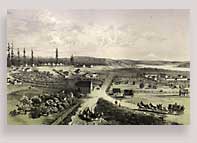Territorial Timeline

Fort Vancouver moved and rebuilt
To be more convenient to shipping, in 1829 Fort Vancouver was moved from Belle Vue Point to its present location. Dr. John McLoughlin, Chief Factor of Fort Vancouver, imported sawmill equipment, installed a forge and planted the first fruit trees along the Columbia River. As the only source of supplies for the settlers in the Pacific Northwest, Fort Vancouver was the destination of overland travelers.
At the height of its power in 1845, Fort Vancouver consisted not only of the stockade areas but also a sizeable village. The fort proper was 150 yards wide by 250 yards long, enclosed by a wooden wall made of upright timbers twenty feet high. On the northwest corner was a bastion with 12-pounder cannons and additional cannons in the center of stockade. Within the stockade were numerous log buildings arranged around a central courtyard. These included offices, officers' quarters, fur warehouses, and workshops for carpenters, blacksmiths, and other skilled workers. Just outside the gates of the fort was the Chief Factor's mansion, a schoolhouse, and a library. Nearby were orchards, cultivated fields, and corrals and pastures for the fort's stock of horses, cattle, and sheep.
For many years, the center of white civilization in the Pacific Northwest was Fort Vancouver. As the only place where settlers could rest and re-supply after months on the Oregon Trail, it was the goal of many of the early pioneers. Fort Vancouver also served as the most important trading center where Indians and whites alike came to trade furs for manufactured goods, flour, beans, coffee, sugar, and other necessities.